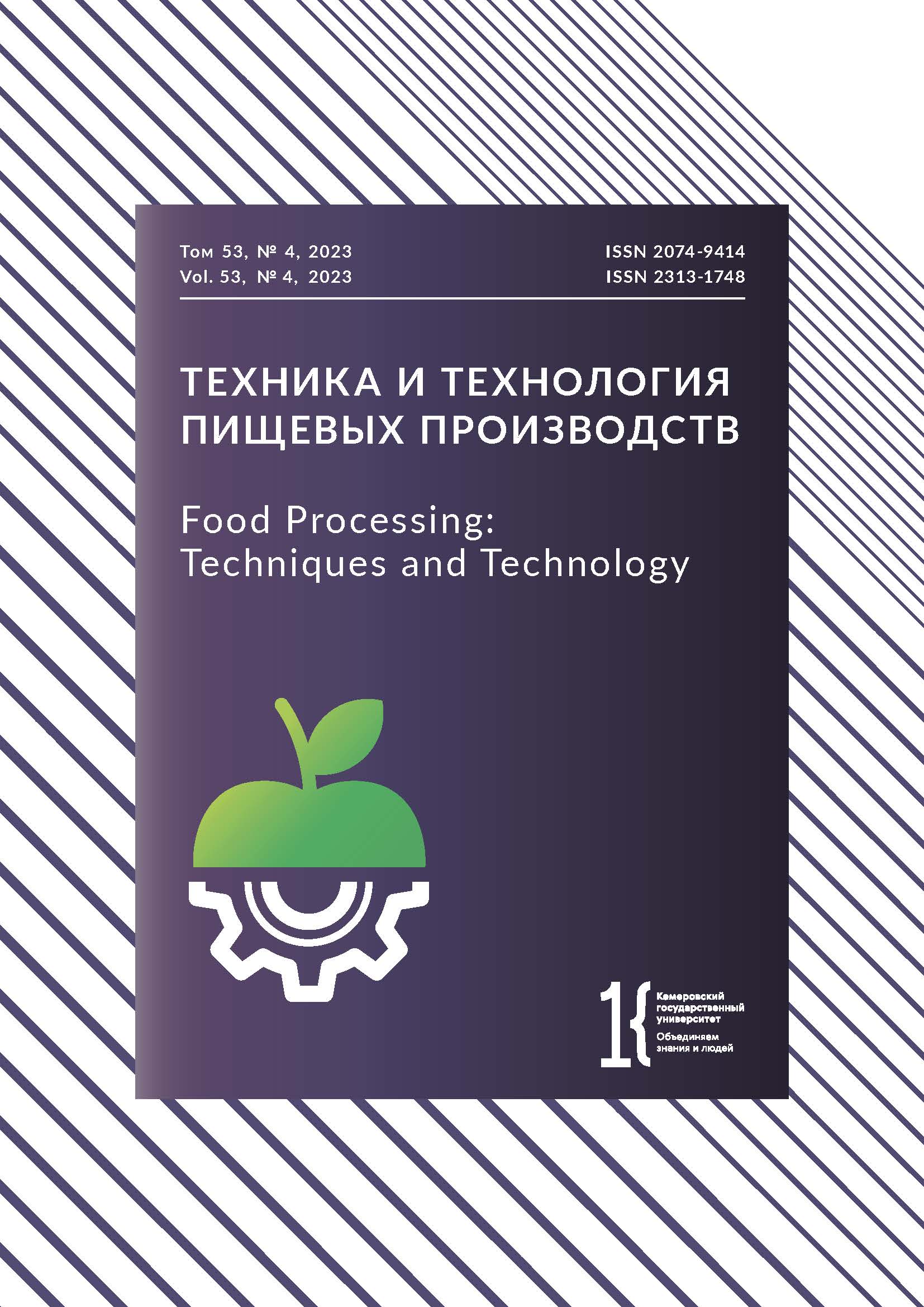Moscow, Russian Federation
Moscow, Russian Federation
Moscow, Russian Federation
Distilled alcoholic drinks are popular all over the world. Monitoring the quality and safety of such drinks requires modern instrumental methods. Chemical composition of alcoholic beverages has become focus of numerous experimental and theoretical publications. However, this area remains understudied. This research provided an experimental confirmation of the capillary electrophoresis as a prospective method for determining anions in alcoholic beverages. The study involved model solutions and 30 samples of distilled alcoholic beverages purchased by random sampling from a retail chain. The chemical analysis relied on a PrinCE 560 capillary electrophoresis system equipped with a conductometric detector. The study revealed the working parameters for electrophoretic analysis that provided a selective qualitative and quantitative test of five target analytes in 9 min. The optimal composition of the buffer solution and the optimal electrolyte ratios were 30 mmol/dm3 L-Histidine and 30 mmol/dm3 2-(N-Morpholino) ethanesulfonic acid Monohydrate. The correlation between the peak area and the mass concentration was at 0.1–10 mg/dm3 for the target analytes. The approach proved effective in determining chloride, nitrate, sulfate, fluoride, and phosphate ions in whiskey, rum, tequila, moonshine, grain, and rum distillates. The study also included a comparative analysis of the qualitative and quantitative anion profiles in whiskey samples from different countries. All the samples contained 0.22–52.74 mg/dm3 chlorides, 0.60–0.06 mg/dm3 nitrates, 0.25–17.59 mg/dm3 sulfates, and 0.75–12.70 mg/dm3 phosphates. Research prospects include a metrologically certified method to identify the anion composition of organic and inorganic acids in distilled alcoholic beverages.
Whiskey, capillary electrophoresis, distillates, identification, anions, rum, samogon, tequila, conductometric detection, import substitution
1. Walker GM, Stewart GG. Saccharomyces cerevisiae in the production of fermented beverages. Beverages. 2016;2(4).https://doi.org/10.3390/beverages2040030
2. Pauley M, Maskell D. Mini-review: The role of Saccharomyces cerevisiae in the production of gin and vodka. Beverages. 2017;3(1). https://doi.org/10.3390/beverages3010013
3. Cabrera-Toledo D, Mendoza-Galindo E, Larranaga N, Herrera-Estrella A, Vásquez-Cruz M, Hernández-Hernández T. Genomic and morphological differentiation of spirit producing Agave angustifoliatraditional landraces cultivated in Jalisco, Mexico. Plants. 2022;11(17). https://doi.org/10.3390/plants11172274
4. Terán-Bustamante A, Martínez-Velasco A, Castillo-Girón VM, Ayala-Ramírez S. Innovation and technological management model in the tequila sector in Mexico. Sustainability. 2022;14(12). https://doi.org/10.3390/su14127450
5. Nikitina SYu, Shahov SV, Pyl'nyj DV, Rudakov OB. Analytical control of the quality of the rectated ethanol, water and alcohol distillates. Food Industry. 2018;(6):56-60. (In Russ.). https://elibrary.ru/XUMWOL
6. Shelekhova NV, Shelekhova TM, Skvortsova LI, Poltavskaya NV. Gas chromatography-mass spectrometryof volatile organic impurities in whiskey. Food Processing: Techniques and Technology. 2022;52(4):787-796. (In Russ.).https://doi.org/10.21603/2074-9414-2022-4-2406
7. Oganesyants LA, Krikunova LN, Dubinina EV, Shvets SD. Evaluation of the fermentation activators use prospects in the technology of corneliancherries distillates. PolzunovskiyVestnik. 2020;(3):24-30. (In Russ.). https://doi.org/10.25712/ASTU.2072-8921.2020.03.004
8. Ageyeva NM, Shirshova AA, Tikhonova AN. Influence of alcoholic and malolactic fermentation on the levelof biogenic amines in wine. Food Processing: Techniques and Technology. 2021;51(3):449-457. (In Russ.). https://doi.org/10.21603/2074-9414-2021-3-449-457
9. Krikunova LN, Dubinina EV, Peschanskaya VA, Ulyanova EV. New nitrogen-containing raw materials in distillatetechnology. Food Processing: Techniques and Technology. 2022;52(1):123-132. (In Russ.). https://doi.org/10.21603/2074-9414-2022-1-123-132
10. ShelekhovaNV. Express method to determine volatile organic impurities in alcoholic distilled beverages based on a combination of GC/FID and GC/MSD. Sorption and Chromatography Processes. 2022;22(1):58-68. https://doi.org/10.17308/sorpchrom.2022.22/9021
11. Shelekhova NV, Shelekhova TM, Skvortsova LI, Poltavskaya NV. Methods gas chromatography, capillary electrophoresis, chromatography-mass spectrometry in analytical control of alcoholic beverages. FoodIndustry. 2021;(9):63-64. (In Russ.). https://doi.org/10.52653/PPI.2021.9.9.028
12. Nikitina SYu, Shahov SV, Gordienko AS. Experience in implementing a new technology for the joint production of rectified ethyl alcohol and alcohol distillate from fermented grain raw materials. Beer and Beverages.2020;(4):10-15. (In Russ.). https://doi.org/10.24411/2072-9650-2020-10037
13. Burachevskiy II, Vorobʹva EV, Zenina GP, Morozova SS. Distillery production technology. Moscow: Pishchepromizdat; 2011. 357 p. (In Russ.).
14. Makeeva DV, Antipova KS, Kartsova LA. Electrophoretic determination of carboxylic acids in blood serum with intracapillary concentration. Analytics and Control. 2022;26(1):13-20. (In Russ.). https://doi.org/10.15826/analitika.2022.26.1.001
15. Navarro-Abril A, Saurina J, Sentellas S. Simultaneous determination of amino acids and biogenic amines by liquid chromatography coupled to mass spectrometry for assessing wine quality. Beverages. 2022;8(4). https://doi.org/10.3390/beverages8040069
16. Farsang R, Kovacs Z, Jarvas G, Guttman A. Ultrahigh-sensitivity capillary electrophoresis analysis of trace amounts of nitrate and nitrite in environmental water samples. Separations. 2022;9(11). https://doi.org/10.3390/separations9110333
17. Rochte JD, Berglund KA. Preliminary studies on the use of reactive distillation in the production of beverage spirits. Beverages. 2019;5(2). https://doi.org/10.3390/beverages5020029
18. Karyakin AV, Petrosyan TsL, Dzhanpoladyan LM. Mineral composition of cognac barrel wood. Winemaking and viticulture of the USSR. 1972;(4):23-24. (In Russ.).
19. Skurikhin IM. Chemical processes during cognac aging in oak barrels. Winemaking and viticulture of the USSR. 1960;(1):8-15.(In Russ.).
20. Harrison B, Fagnen O, Jack F, Brosnan J. The impact of copper in different parts of malt whisky pot stills on new make spirit composition and aroma. Journal of the Institute of Brewing. 2011;117(1):106-112. https://doi.org/10.1002/j.2050-0416.2011.tb00450.x
21. Wanikawa A, Sugimoto T. A narrative review of sulfur compounds in whisk(e)y. Molecules. 2022;27(5). https://doi.org/10.3390/molecules27051672
22. Buglass AJ. Handbook of alcoholic beverages: Technical, analytical and nutritional aspects. John Wiley & Sons; 2011. 1208 p. https://doi.org/10.1002/9780470976524












